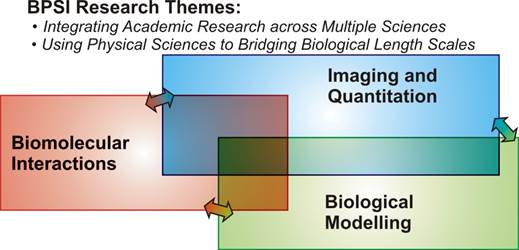Research Areas
Scientific areas of the BPSI are divided broadly into three inter-related strands of research excellence with several members of the BPSI interfacing multiple strands.
- Imaging and Quantitation
- Biomolecular Interactions
- Biological Modelling (Fig 1)
Many of our academic members have multiple links to industry, both through several international companies and via multiple SMEs, as well as links to the NHS through Hull York Medical School, intertwining the scientific strands to ensure a constructive engagement to both UK plc and to the improvement in wellbeing through related translational clinical impact into healthcare.

Figure 1 The primary scientific strands that knit together the members of the BPSI
Strand 1: Imaging and Quantitation of Complex Data.
Members of the BPSI have considerable expertise in designing and exploiting novel imaging techniques to help address life science challenges to improve our basic understanding of biological processes. The application to real biological problems is our primary driver.
Some of our academics in the BPSI have worked on designing artificial tissues for applications in immunology, skin, stem cell and cancer research, while others are developing novel imaging technologies and strategies that enable label-free imaging, removing cost barriers to high-throughput imaging, and improving the resolution of microscopy.
These technologies can monitor functional bacteria and a range of sub-cellular localization effects in isolated cells, complemented by high-resolution EM and single-cell manipulation applied to bio-electronics. We use cutting-edge correlated electron/light microscopy with bespoke image analysis to objectively quantify cell shape, size and dynamics in real-time; improvement of these approaches are constantly demanding developments in new chemistries and physical detectors.
References: 1. Nature 2007 446:547; 2. Science 2012 338:528; 3. Nature 2006 443:355 4. Science 2010 328:498.
Strand 2: Biomolecular Interactions.
The BPSI have world-class academics focused on several challenging biomolecular questions which span multiple length scales from single molecules up to interacting cells. We have particular strengths in probing single-molecule protein-nucleic acid interactions using bespoke biophysical tools. We also have expertise in the development of small, synthetic molecules for biomimetic templates, as well as the design and implementation of hyperpolarization probes for use in NMR. In addition, we have strong research interests of microenvironmental engineering including skin therapeutics and the development of engineered tissues. The experimental research in our broad biological engineering programmes is complemented significantly by an array of in silico computational modelling techniques. We study stem cell technology on the effects of cell growth/differentiation as well as uncontrolled cell division in epithelial tissue cancer, and develop new nanomaterials as bio-mimetic technologies. We also investigate self-assembled bio-nanostructures from dendrimer building blocks to transition metals in native enzymes.
References: 5. PNAS 2013 110:7252; 6. PRL 2009 103:115703; 7. Science 2009 323:1708.
Strand 3: Biological Modelling.
Maths provides the language to model complex biosystems. Several depts from the University of York from which the BPSI draws its members have made strategic joint appointments linking maths/computer sciences and biology, developing practical bridges over traditional subject boundaries to explore a range of deep biological problems over scales from molecules to ecosystems, sitting in a unifying theme of biosystems dynamics: probing evolutionary, ecological and social networks, through cell behaviour, to genomic/metabolic, structure/function. Expertise is shared and enhanced via strong discipline interactions.We study methods from dynamical systems, stochastic processes and fluid dynamics to reveal multi-scale effects and emergent phenomena in bio-inspired models. We have shown how physics influences biology and scales up through sub-cellular to ecological and evolutionary scales. Applications include fluid dynamics of suspensions of cells, bioconvection, quorum-sensing in biofilms, and ecosystem dynamics and evolution.
There are strong research interests covering network interaction analysis of artificial in silico immune systems and protein-network characterization, backed up by rigorous theory. We have developed complex methods to investigate the developing tissue and tissue engineering scaffolds, leading to practical biomedical impact.We also model sub-cellular biological phenomena, including rheology of the intracellular environment, transport properties of biopolymers, Bayesian modelling of toxicity, and the energetics of viral capsid structure and invasion.
References: 8. Nature 2012 487:227; 9. PRL 2008 101:168102; 10. Acta Crystallogr A 2013 69:140.
